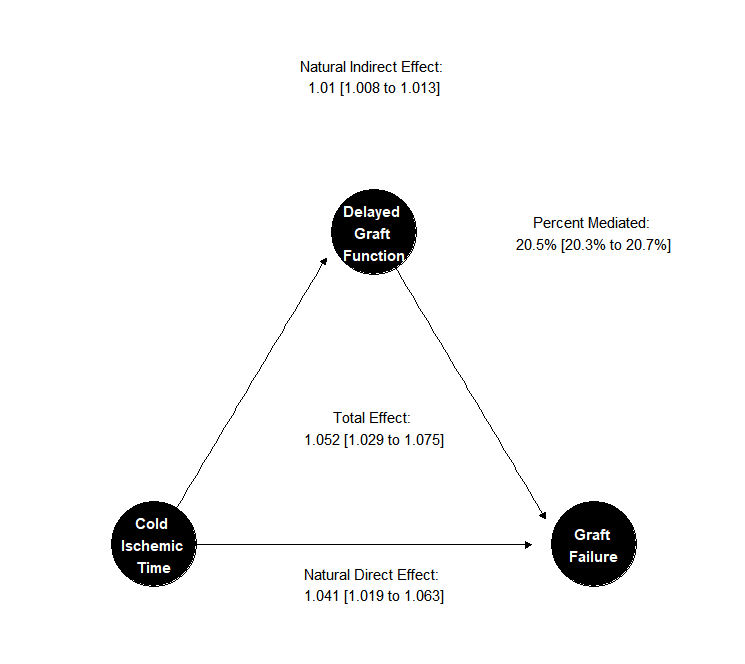Cold Ischemic Time and Kidney Graft Failure; Mediation Through Delayed Graft Function
1Scientific Registry of Transplant Recipients, Minneapolis, MN, 2Department of Surgery, East Carolina University, Greenville, NC, 3Division of Nephrology and Hypertension, Weill Cornell Medical College, New York, NY, 4Division of Surgery, Johns Hopkins School of Medicine, Baltimore, MD
Meeting: 2022 American Transplant Congress
Abstract number: 701
Keywords: Graft function, Ischemia, Kidney transplantation
Topic: Clinical Science » Kidney » 31 - Kidney Deceased Donor Allocation
Session Information
Session Name: Kidney Deceased Donor Allocation
Session Type: Poster Abstract
Date: Saturday, June 4, 2022
Session Time: 5:30pm-7:00pm
 Presentation Time: 5:30pm-7:00pm
Presentation Time: 5:30pm-7:00pm
Location: Hynes Halls C & D
*Purpose: Delayed graft function (DGF) has been associated with decreased graft survival and prolonged cold ischemia time (CIT) has been proposed as a modifiable DGF risk factor. We aimed to estimate the impact of CIT on kidney transplant graft-failure as mediated through DGF.
*Methods: Using Scientific Registry of Transplant Recipients data, we included kidney alone, deceased donor transplant recipients between January 1, 2015 and December 31, 2019 aged 18 years or older at transplant who did not experience graft failure within the first 7 days. The Vanderweele decomposition method of mediation analysis, which allows for predictor-mediator interaction, was used to estimate the effect of CIT on risk of graft failure and the percent of the effect that is mediated through DGF, adjusted for donor and recipient risk factors. Hazard ratio (HR) and 95% confidence interval (CI) are presented as measures of strength of association and precision, respectively.
*Results: Mediation effect of CIT is graphically displayed in Figure 1. The total effect estimate of CIT (8 hours versus 0 hours) on risk of graft failure, irrespective of DGF was HR = 1.052 (95% CI=1.029-1.075). When allowing for a mediation interaction between CIT and DGF, the natural indirect effect of CIT through DGF was estimated to be HR=1.01 (95% CI=1.008-1.013). Using Vanderweele decomposition method, the percentage effect of CIT on risk of graft failure, mediated through DGF is 20.5% (95% CI=20.3-20.7%).
*Conclusions: Increasing CIT in kidney transplant significantly impacts risk of graft failure. Twenty percent of the effect of CIT, however, is mediated through DGF. While intervening to reduce DGF may reduce part of the effect of CIT, there seem to be other pathways through which CIT affects graft failure, independent of DGF. Strategies to reduce CIT and/or the impact of CIT are warranted given its dual influence on DGF risk as well as graft failure.
To cite this abstract in AMA style:
Miller J, Irish W, Sawinski D, Massie A, Snyder J. Cold Ischemic Time and Kidney Graft Failure; Mediation Through Delayed Graft Function [abstract]. Am J Transplant. 2022; 22 (suppl 3). https://atcmeetingabstracts.com/abstract/cold-ischemic-time-and-kidney-graft-failure-mediation-through-delayed-graft-function/. Accessed December 21, 2025.« Back to 2022 American Transplant Congress

